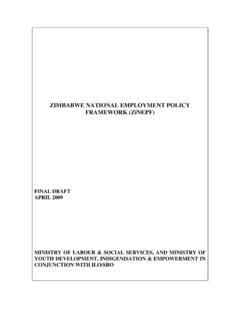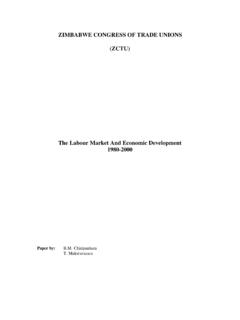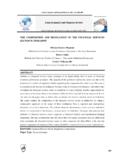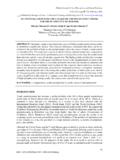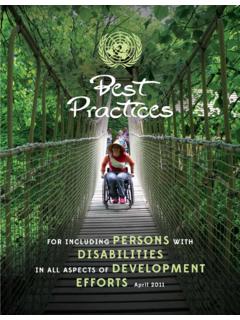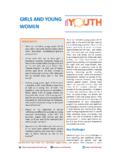Transcription of Do Age-Disparate Relationships Drive HIV Incidence in ...
1 EPIDEMIOLOGY AND PREVENTION. Do Age-Disparate Relationships Drive HIV Incidence in Young Women? Evidence from a Population Cohort in Rural KwaZulu-Natal, South Africa Guy Harling, ScD,* Marie-Louise Newell, PhD, Frank Tanser, PhD, Ichiro Kawachi, MD, PhD,*. Subramanian, PhD,* and Till B rnighausen, MD, ScD . years older: HR, ; 95% CI: to ; man $10 years older: Background: Based on ethnographic investigations and mathe- HR, ; 95% CI: to ). These results were robust to matical models, older sexual partners are often considered a major adjustment for known sociodemographic and behavioral HIV risk risk factor for HIV for young women in sub-Saharan Africa. factors and did not vary signi cantly by women's age, marital status, Numerous public health campaigns have been conducted to education attainment, or household wealth. discourage young women from Relationships with older men.
2 However, longitudinal evidence relating sex partner age disparity Conclusions: HIV Incidence in young women was very high in to HIV acquisition in women is limited. this rural community in KwaZulu-Natal. Partner age disparity did not predict HIV acquistion. Campaigns to reduce Age-Disparate sexual Methods: Using data from a population-based open cohort in rural Relationships may not be a cost-effective use of HIV prevention KwaZulu-Natal, South Africa, we studied 15- to 29-year-old women resources in this setting. who were HIV seronegative at rst interview between January 2003. and June 2012 (n = 2444). We conducted proportional hazards anal- Key Words: HIV, sexual behavior, South Africa, women ysis to establish whether the age disparity of women's most recent (J Acquir Immune De c Syndr 2014;66:443 451). sexual partner, updated at each surveillance round, was associated with subsequent HIV acquisition.
3 Results: A total of 458 HIV seroconversions occurred over 5913 INTRODUCTION. person-years of follow-up ( Incidence rate: per 100 person- In recent years, there has been much concern in sub- years). Age disparate Relationships were common in this cohort; Saharan Africa regarding Age-Disparate Relationships . Most of women reported a partner 5 or more years older than current National Strategic HIV Plans in countries with themselves. The age disparity of women's partners was not associ- generalized epidemics name Age-Disparate Relationships as ated with HIV acquisition when measured either continuously [haz- a driver of the HIV epidemic (Table 1). The World Health ard ratio (HR) for 1-year increase in partner's age: , 95% Organization considers sexual partnerships between young con dence interval (CI): to ] or categorically (man $5 women and substantially older men as an important contrib- utor to young women's risk of HIV Received for publication September 18, 2013; accepted April 3, 2014.)
4 This concern is based on the observation of three types From the *Department of Social and Behavioral Sciences, Harvard School of of ecological associations. First, the distribution of HIV. Public Health, Boston, MA; Africa Centre for Health and Population Incidence and prevalence in predominantly sexually trans- Studies, University of KwaZulu-Natal, Mtubatuba, South Africa; Faculty mitted epidemics is consistently shifted toward higher rates at of Medicine, University of Southampton, Southampton, United Kingdom;. and Department of Global Health and Population, Harvard School of younger ages for women compared with men. One explana- Public Health, Boston, MA. tion for this pattern is that HIV is commonly transmitted from acknowledges support from the Harvard University Committee on an older man to a younger female partner. Second, sub- African Studies for travel to the research site for this study.
5 The Wellcome Saharan Africa has the largest relationship age disparities3. Trust, United Kingdom, provides core funding to the Africa Centre, including for the surveillance on which this work is based (grant 082384/ and the highest HIV prevalence1 in the world. Third, Z/07/Z). and received nancial support through grant 1R01- population-level variation in age disparity and HIV preva- HD058482-01 from the National Institute of Child Health and Human lence also appears to positively covary within regions of Development, National Institutes of Health. The funders had no role in sub-Saharan study design, data collection and analysis, decision to publish, or As a result, numerous public health campaigns have preparation of the manuscript. The authors have no con icts of interest to disclose. been implemented, aiming to discourage young women from Supplemental digital content is available for this article.
6 Direct URL citations engaging in sexual Relationships with substantially older appear in the printed text and are provided in the HTML and PDF partners or sugar daddies. 5 The nongovernmental organiza- versions of this article on the journal's Web site ( ). tion Population Services International has run health messag- Correspondence to: Guy Harling, ScD, Department of Social and Behavioral Sciences, Harvard School of Public Health, 677 Huntington Avenue, ing programs targeting Age-Disparate Relationships in at least 8. Boston, MA 02115 (e-mail: sub-Saharan In 2012, the KwaZulu-Natal (KZN). Copyright 2014 by Lippincott Williams & Wilkins provincial Department of Health in South Africa began J Acquir Immune Defic Syndr Volume 66, Number 4, August 1, 2014 | 443. Harling et al J Acquir Immune Defic Syndr Volume 66, Number 4, August 1, 2014. TABLE 1.)
7 National Strategic Plans Containing References to Age-Disparate Sexual Relationships % HIV Age Disparity or Sugar Prevalence NSP Daddy Cited as Risk Explicit Reduction (15 49 years)* Period Factor Justi cation Given Policies Mandated Target Set Swaziland 2009 14 Yes Prevalence of Mandated, no speci c intergenerational sex, policy especially among out- of-school young women Botswana 2010 16 Yes Older men have longer Mandated, no speci c sexual history; young policy women having intergenerational sex have lower condom use Lesotho 2012 16 Yes None Yes Increase BCC coverage . South Africa 2012 16 Yes Intergenerational Yes Relationships increase risk of HIV exposure Zimbabwe 2011 15 Yes Intergenerational sex is Mandated, no speci c a factor that makes policy women and girls more vulnerable Namibia 2011 16 Yes Sugar daddy phenomenon Yes . well known in Namibia.
8 Intergenerational sex associated with STIs, multiple and concurrent partnerships and introduction of HIV. into younger cohort Zambia 2011 15 Yes Yes Mozambique 2010 14 Yes Sexual relations between individuals from different generations associated with transactional and less- safe sex Malawi 2009 13 Yes Yes Uganda 2011/12 Yes Prevalence of cross- Yes Reduce cross-generational 14/15 generational sex (15- to sex by 50% by 2015 . 19-year-old women with men at least 10. years older) . Kenya 2008/09 No Transactional 12/13 Relationships may be important but sugar daddy Relationships are possibly less frequent than generally thought Tanzania 2008 12 Yes Prevalence of cross- Yes Reduce cross-generational generational sex, which sex by 50% for teenage is linked to girls by 2025. transactional sex and multiple concurrent partnerships Cameroon 2011 15 Yes No Central African 2006 10 No Republic Nigeria 2010 15 Yes Yes 444 | 2014 Lippincott Williams & Wilkins J Acquir Immune Defic Syndr Volume 66, Number 4, August 1, 2014 Age Disparities and HIV in Rural South Africa TABLE 1.
9 (Continued ) National Strategic Plans Containing References to Age-Disparate Sexual Relationships % HIV Age Disparity or Sugar Prevalence NSP Daddy Cited as Risk Explicit Reduction (15 49 years)* Period Factor Justi cation Given Policies Mandated Target Set Togo 2012 15 Yes Prevalence of No intergenerational Relationships is increasing and is a source of infections among young women Congo 2009 13 No Chad 2007 11 Yes No C te d'Ivoire 2011 15 Yes Young people in sexual Mandated, no speci c 80% of youth adopt lower Relationships with older policy risk sexual behaviors partners lack negotiating power Rwanda 2009 12 Yes Disparity in HIV Yes prevalence among 20- to 24-year-old men and women attributed to cross-generational sex Based on the most recent NSP available for countries with adults HIV prevalence more than 2% in 2011. No NSPs published since 2002 were available for Angola, Equatorial Guinea, Gabon or Guinea-Bissau.
10 *HIV prevalence for 2011 from UNAIDS Report on the global AIDS epidemic From an accompanying National Prevention Strategy rather than National Strategic Plan. BCC, Behaviour change communication; NSP, National Strategic Plan; STI, sexually transmitted infection. a campaign under the title ' Sugar Daddies Destroy Lives', because the economic and social power differentials arising aiming to create a taboo against cross-generational sex from the age disparity may make it dif cult for women to involving 14- to 25-year-old women in order to reduce HIV negotiate safe sex with their older ,14 For example, there is some evidence that men are less likely to use con- Despite these considerable investments, quantitative evi- doms in sexual Relationships with younger ,16 The dence for a causal relationship between age disparities and HIV subset of Age-Disparate Relationships involving sugar dad- remains very limited.
